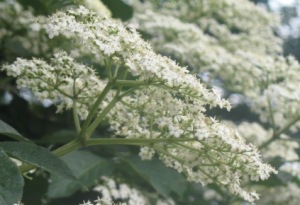 While making this fizz isn’t particularly complicated, it can go wrong, mainly if the equipment isn’t totally sterile. Mildly alcoholic, it depends on the natural yeasts that appear on the flowers, so you have to a) collect the flowers early in the morning on a dry day when they have most pollen and b) collect perfect freshly opened heads and check for insects before you cut them…(the freshest heads often have a slightly concave shape). This is because you can’t wash the flowers – lay the flowerheads out on some paper when you get home, and any wee beasties will crawl away.
While making this fizz isn’t particularly complicated, it can go wrong, mainly if the equipment isn’t totally sterile. Mildly alcoholic, it depends on the natural yeasts that appear on the flowers, so you have to a) collect the flowers early in the morning on a dry day when they have most pollen and b) collect perfect freshly opened heads and check for insects before you cut them…(the freshest heads often have a slightly concave shape). This is because you can’t wash the flowers – lay the flowerheads out on some paper when you get home, and any wee beasties will crawl away.
As I said in the post for Elderflower cordial, please forage responsibly 🙂
Ingredients
30 heads of elderflowers
1kg sugar, preferably castor
3 unwaxed lemons, zested and juiced
3 tbsp white wine or cider vinegar
8 litres of water
You need a very clean bucket, or a stainless steel or enamel pan of 10 litres capacity,
and very clean ex fizzy drinks bottles to take 8-9 litres.
Method
Pick over your flowers for bugs, remove as many flowers as you can from their stalks, then snip away as much stalk as possible. Add the sugar and 2-3 litres of water to your receptacle, and stir until the sugar has dissolved.
Add the rest of the water, then elderflowers along with the juice, zest and vinegar. Cover with a clean piece of damp muslin and leave in a cool place for 2-3 days, stirring once a day with a sterile utensil.
If, after the 2nd day, it is not starting to gently bubble/show some signs of (subtle) effervescence you can add a pinch of yeast and stir again, but you shouldn’t need to do this. If you do, cover again and leave for another 2-3 days, allowing it to ferment and brew.
Strain the liquid carefully through a sieve lined with double muslin and funnel into strong fizzy drinks plastic bottles. The potion can produce a lot of gas, so you need to check and release some gas out – don’t take the screwtops off completely, as this might let in unwanted bacteria in the air. This is known as ‘burping the bottles’!
If you forget, the bottles will fall over – which is the great advantage of using plastic over glass, which could just explode. I keep mine in the bathroom, just in case I end up with an overflowing bottle and a sticky mess.
It is ready to drink after 2-3 weeks. It is only mildly alcoholic, but it is very moreish.
